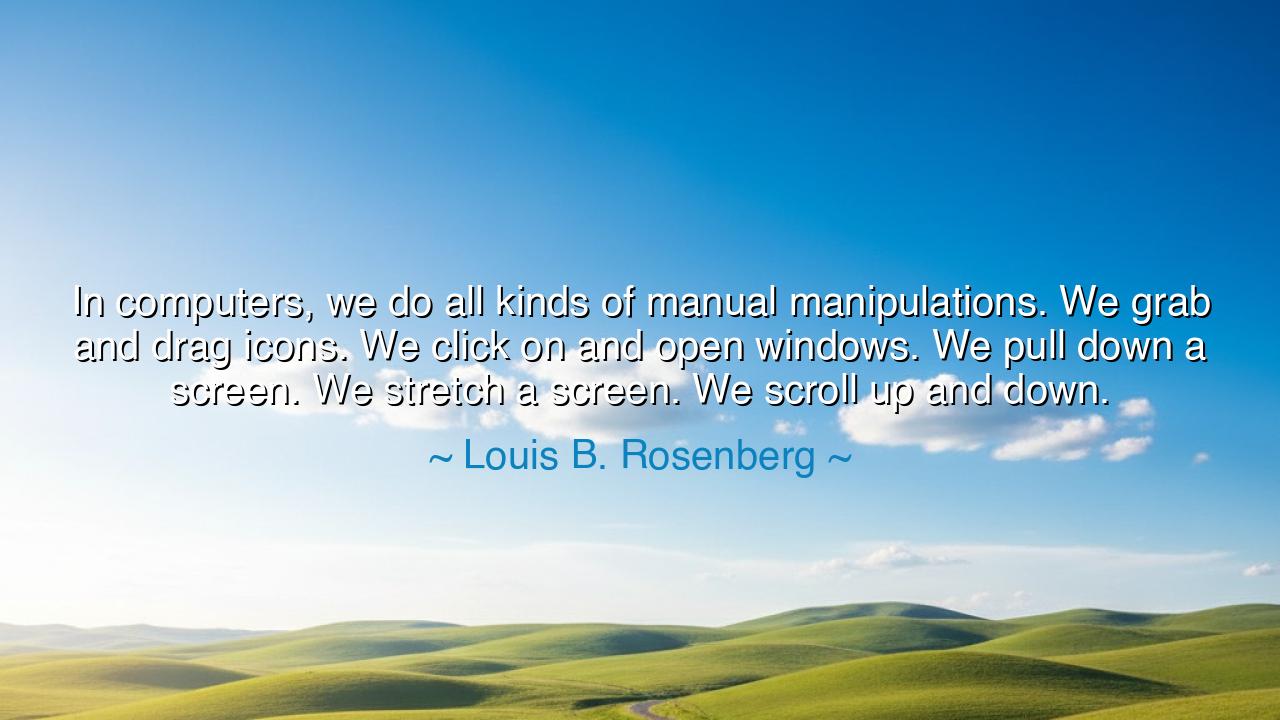
In computers, we do all kinds of manual manipulations. We grab
In computers, we do all kinds of manual manipulations. We grab and drag icons. We click on and open windows. We pull down a screen. We stretch a screen. We scroll up and down.






In the words of Louis B. Rosenberg, a visionary of technology and the digital age, we find a reflection of humanity’s profound relationship with its own creations: “In computers, we do all kinds of manual manipulations. We grab and drag icons. We click on and open windows. We pull down a screen. We stretch a screen. We scroll up and down.” At first glance, these words seem simple — a description of what we do every day in the digital realm. Yet beneath their surface lies a deeper meditation on the merging of man and machine, the evolution of touch from the physical world into the virtual, and the eternal desire of humanity to make the intangible real through action.
The ancients once said that the hand is the servant of the mind, the instrument through which thought becomes creation. In the age of stone and fire, hands shaped tools and carved symbols. In the age of bronze and parchment, they built cities and wrote histories. And now, in the age of computers, those same hands perform new rituals — gestures of command, gestures of power. We no longer lift hammers or quills; we drag icons, click windows, and scroll through realms unseen. Yet the essence remains the same — the human impulse to shape, to control, to give form to the formless. Rosenberg’s words remind us that though our world has changed, the sacred dialogue between thought and action endures.
The origin of these gestures lies in a great revolution — the birth of human-computer interaction. In the beginning, machines were cold and distant, bound by numbers and command lines, accessible only to the few who spoke their language. But visionaries like Douglas Engelbart, the inventor of the mouse, dreamed of a world where interaction could be natural, where technology could become an extension of the body itself. He imagined a partnership between human intuition and digital precision. And from that dream emerged the language of the modern world — the click, the drag, the scroll, the silent choreography through which billions now move across invisible landscapes every day.
Yet Rosenberg’s reflection is not just a celebration of innovation; it is also a meditation on transformation. For every time we pull down a screen or open a window, we enact an ancient ritual in a new form. Once, the seeker of truth opened scrolls of parchment; now, we open digital windows upon infinite knowledge. Once, a scholar turned the pages of a book; now, we scroll through rivers of text that never end. The gestures are different, but the yearning is the same — the human desire to reach beyond the limits of flesh, to touch what cannot be touched, to hold in our hands the boundless expanse of thought.
Consider how this transformation mirrors the evolution of civilization itself. When Gutenberg forged the printing press, he changed the world by giving every hand the power to hold knowledge. Today, computers have multiplied that power a thousandfold. A child’s fingers upon a keyboard can summon wisdom from every corner of the earth. But with such power comes peril. For in mastering our tools, we must not become enslaved by them. The same hand that scrolls endlessly through distraction can also create, build, and learn. The difference lies in awareness — in remembering that the machine is an extension of man, not his master.
Let us then take Rosenberg’s words as a teaching: technology is not to be feared nor worshipped, but understood and directed. The gestures of the hand must serve the wisdom of the heart. To click is to choose, to drag is to shape, to scroll is to seek — these are not empty motions but reflections of the mind’s purpose. When we act without intention, we become lost in the endless scroll of illusion. But when we act with clarity, even a simple click can be an act of creation, an expression of will and awareness.
The lesson for our time is thus: do not forget the sacredness of your gestures, even in the digital world. Each motion you make before the screen mirrors an ancient truth — that humanity’s greatest power lies not in its tools, but in its ability to imbue them with meaning. Use technology to expand, not escape. Let your hands, whether holding a pen or a mouse, be instruments of learning, compassion, and purpose. For in every window we open, we reveal not just a part of the digital world, but a reflection of our own spirit.
And so, as Rosenberg teaches, the gestures of modern man — simple, silent, and swift — are the heirlooms of ancient creativity. We grab, drag, and scroll not merely to move pixels, but to continue the timeless act of shaping reality. The tools have changed, but the story has not. The hand still serves the mind, the mind still seeks truth, and through the smallest movement — a click, a touch — humanity continues its eternal dialogue with creation itself.






AAdministratorAdministrator
Welcome, honored guests. Please leave a comment, we will respond soon